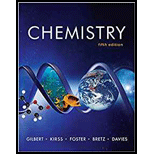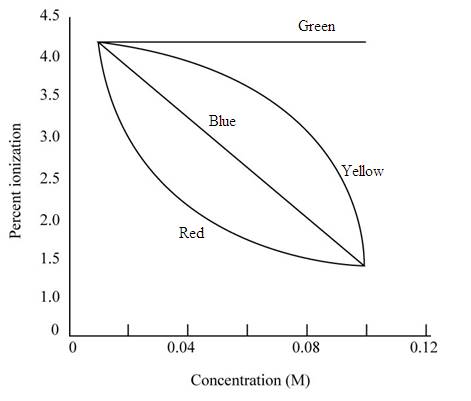
Concept explainers
Interpretation: The line in the given Figure that best represents the dependence of the degree of ionization of acetic acid on its concentration in aqueous solution is to be stated.
Concept introduction: Degree of ionization is defined as the ratio of the number of molecules ionized in an aqueous medium to the total number of molecules dissolve in the aqueous medium. The measure of concentration of ions in a solution gives the ionic strength of the solution.
To determine: The line in the given Figure that best represents the dependence of the degree of ionization of acetic acid on its concentration in aqueous solution.
Answer to Problem 15.1VP
Solution
The red line best represents the nature of acetic acid.
Explanation of Solution
Explanation
The given figure is,

Figure 1
The given acid is acetic acid which is a weak acid. The degree of ionization is inversely proportional to the square root of molar concentration according to Ostwald’s dilution law.
In the given graph, the green line shows that there is no effect of concentration on the degree of ionization. Therefore, it is not applicable for an acetic acid. The yellow line shows a tremendous change in the degree of ionization by the change in concentration, this does not happen for a weak acid like an acetic acid.
Therefore, it does not represent acetic acid. The blue line represents the change in degree of ionization by the change in concentration in a continuous manner. In a weak acid, the change in degree of ionization is not continuous. Thus, it also does not represent acetic acid. The red line shows that the degree of ionization increases with the decrease in concentration of an acid.
Thus, the red curve represents the degree of ionization for the acetic acid.
Hence, in all the lines shown in Figure 1, red line best represents the nature of acetic acid.
Conclusion
The red line best represents the dependence of the degree of ionization of acetic acid on its concentration in aqueous solution.
Want to see more full solutions like this?
Chapter 15 Solutions
CHEMISTRY:SCI.IN CONTEXT (CL)-PACKAGE
- What is the final product when D-galactose reacts with hydroxylamine?arrow_forwardIndicate the formula of the product obtained by reacting methyl 5-chloro-5-oxopentanoate with 1 mole of 4-penten-1-ylmagnesium bromide.arrow_forwardIn the two chair conformations of glucose, the most stable is the one with all the OH groups in the equatorial position. Is this correct?arrow_forward
- please help me with my homeworkarrow_forwardhelparrow_forwardThe temperature on a sample of pure X held at 1.25 atm and -54. °C is increased until the sample boils. The temperature is then held constant and the pressure is decreased by 0.42 atm. On the phase diagram below draw a path that shows this set of changes. pressure (atm) 2 0 0 200 400 temperature (K) Xarrow_forward
- QUESTION: Answer Question 5: 'Calculating standard error of regression' STEP 1 by filling in all the empty green boxes *The values are all provided in the photo attached*arrow_forwardpressure (atm) 3 The pressure on a sample of pure X held at 47. °C and 0.88 atm is increased until the sample condenses. The pressure is then held constant and the temperature is decreased by 82. °C. On the phase diagram below draw a path that shows this set of changes. 0 0 200 temperature (K) 400 аarrow_forwarder your payment details | bar xb Home | bartleby x + aleksogi/x/isl.exe/1o u-lgNskr7j8P3jH-1Qs_pBanHhviTCeeBZbufuBYT0Hz7m7D3ZcW81NC1d8Kzb4srFik1OUFhKMUXzhGpw7k1 O States of Matter Sketching a described thermodynamic change on a phase diagram 0/5 The pressure on a sample of pure X held at 47. °C and 0.88 atm is increased until the sample condenses. The pressure is then held constant and the temperature is decreased by 82. °C. On the phase diagram below draw a path that shows this set of changes. pressure (atm) 1 3- 0- 0 200 Explanation Check temperature (K) 400 X Q Search L G 2025 McGraw Hill LLC. All Rights Reserved Terms of Use Privacy Cearrow_forward
 ChemistryChemistryISBN:9781305957404Author:Steven S. Zumdahl, Susan A. Zumdahl, Donald J. DeCostePublisher:Cengage Learning
ChemistryChemistryISBN:9781305957404Author:Steven S. Zumdahl, Susan A. Zumdahl, Donald J. DeCostePublisher:Cengage Learning ChemistryChemistryISBN:9781259911156Author:Raymond Chang Dr., Jason Overby ProfessorPublisher:McGraw-Hill Education
ChemistryChemistryISBN:9781259911156Author:Raymond Chang Dr., Jason Overby ProfessorPublisher:McGraw-Hill Education Principles of Instrumental AnalysisChemistryISBN:9781305577213Author:Douglas A. Skoog, F. James Holler, Stanley R. CrouchPublisher:Cengage Learning
Principles of Instrumental AnalysisChemistryISBN:9781305577213Author:Douglas A. Skoog, F. James Holler, Stanley R. CrouchPublisher:Cengage Learning Organic ChemistryChemistryISBN:9780078021558Author:Janice Gorzynski Smith Dr.Publisher:McGraw-Hill Education
Organic ChemistryChemistryISBN:9780078021558Author:Janice Gorzynski Smith Dr.Publisher:McGraw-Hill Education Chemistry: Principles and ReactionsChemistryISBN:9781305079373Author:William L. Masterton, Cecile N. HurleyPublisher:Cengage Learning
Chemistry: Principles and ReactionsChemistryISBN:9781305079373Author:William L. Masterton, Cecile N. HurleyPublisher:Cengage Learning Elementary Principles of Chemical Processes, Bind...ChemistryISBN:9781118431221Author:Richard M. Felder, Ronald W. Rousseau, Lisa G. BullardPublisher:WILEY
Elementary Principles of Chemical Processes, Bind...ChemistryISBN:9781118431221Author:Richard M. Felder, Ronald W. Rousseau, Lisa G. BullardPublisher:WILEY





